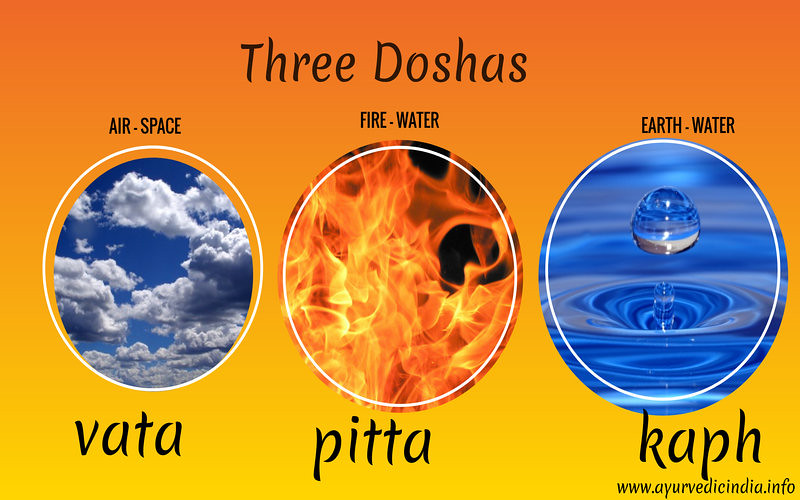What Are the Ayurveda Doshas? Vata, Pitta Kapha Characteristics
We all have noticed or come across many significant peoples in life. You might wonder how that person is intelligent the other is so dumb. Some people eat a five-course meal with ease, even not healthy while others eat two meals and seem to be healthy and fit.

Some people are overweight some are slim; some people are overactive and fast-moving, while other people exude grace and stillness.
Modern science describes it as a genetic reason behind it, the characteristics and peculiarities that make every person incomparable. Ayurveda which is dating back to 1500 BCE has all answers to all of these questions in a much deeper way.
1. Five elements: Panchabhuta – Ayurveda believes that the universe is constituted of bhūmi (earth), ap or Jala (water), Tejas or Agni (fire), Marut, Vayu or Pavan (air or wind), and vyom or shunya (space or zero) or akash (aether or void) that also include the human body.
2. Three doshas: These constitutional types are in of every human known as the doshas – Vata, Pitta, and Kapha. These doshas refer mainly to the functions of motion, digestion, and accumulation.
3. Prakriti: Though all three doshas exist in every human being, there is one dominant base that makes individuals more characteristics that are determined as “Prakriti.” The Prakriti are discreet phenotypes, and they are determined based on physical, physiological, psychological, and behavioral traits that include a person’s social, ethnic, and geographical variables.
What are doshas?
According to the theory of Ayurveda, there are three basic types of energy the universal principles known as the doshas. The doshas are the biological energies that are found throughout the human body and mind.
The doshas are categorized by three branches Vata, pitta, and Kapha these are the main building blocks of the physical world. They regulate all physical and mental processes and provide every living being with an individual blueprint for shape, health, and fulfillment.
All the doshas are found in everyone and everything but with different proportions. They combine to create distinct climates, distinct foods, distinct species, and even distinct individuals within the same species.
The doshas are found within each of us in a particular ratio of Vata, pitta, and Kapha. This dosha has a significant influence on our personal characteristics like physical, mental, and emotional character, etc.
However, the doshas derive from the Five. Elements and their related properties. The Vata is composed of Space and Air, Pitta of Fire and Water, and Kapha of Earth and Water. Now Let’s take a closer look at each of the three doshas briefly.
1. Vata body
The Vata-type people are generally thin, and they generally find it hard to gain weight. Due to attenuated characteristics of nature, Vata’s persons have very little energy reserve and can fatigue easily and get themselves out of equilibrium.
The Vatas types’ persons need to get adequate rest and not overdo things, stay warm and maintain a regular lifestyle routine. The Vata dosha regulates every movement in the body, digestion, nerve impulses from the brain, including breathing.
When the Vata is out of balance the symptoms such as anxiety, nervousness, panic, fears are observed. Besides this, a Vata imbalance also puts down to constipation, digestive problems, cramps, and even premenstrual pains are attributed to imbalances.
The most important part or advantage about Vata is that it leads among all other doshas. However, Vata normally goes out of balance first, which brings out the early stages of sickness.
In Vata persons, more than half of all diseases are due to Vata disturbances. Balancing of Vata is very important for everyone because when Vata is in balance, Pitta and Kapha are generally in balance as well.[1]
5 Types Of Vata Subdoshas With Origin
1. Prana Vata: It Governs inhalation, perception through the senses, and governs the mind.
Origin: It is located in the brain, head, throat, heart, and respiratory organs.
2. Udana Vata: It governs speech, self-expression, effort, enthusiasm, strength, and vitality.
Origin: It is located in the navel, lungs, and throat.
3. Samana Vata: It governs the peristaltic movement of the digestive system.
Origin: It is located in the stomach and small intestines.
4. Apana Vata: It governs all downward impulses (urination, elimination, menstruation, sexual discharges etc.)
Origin: It is located between the navel and the anus.
5. Vyana Vata: It controls heart rhythm, regulates circulation, locomotion.
Origin: It is located at the center of the heart and spread throughout the body.
How Vata Becomes Imbalanced
- Following an irregular daily routine.
- Drinking alcohol, coffee, or black tea.
- Eating while anxious or depressed.
- Eating Vata-aggravating foods.
- Going to bed late at night.
- Eating on the run.
- Smoking cigarettes.
How to balance Vata
- Follow a regular daily routine.
- Engage in wholesome and contemplative activities (like spending time in nature).
- Eat a Vata-balancing diet.
- Do gentle physical exercise like yoga, swimming, tai chi, or walking
- Eat in a peaceful environment.
- Meditate daily.
- Go to bed early.
2. Pitta body
The Pitta-type people are usually of medium size and well proportioned. Due to the medium characteristics of nature, they have a medium amount of physical energy and stamina. The advantage is that they have a positive characteristic in them.
They tend to be brilliant with sharp intelligence and have a good ability to concentrate. The Pitta-type body element consists of fire and water, which give them the characteristic as thoughtless with a short temper.
The fire element consists in Pitta body generally keep their body temperature warm. Their eyes are responsive to light and their body generally goes out of balance by overexposure to the sun. The pitta body type is ambitious by nature but also can be challenging.
They are recognized for their strong digestion power but should be careful not to abuse it. The fire characteristic in it generally makes them thirsty. So they should take caution not to douse their Agni or digestive fire with too much liquid during meals.
Pitta dosha principal characters can crave moderation and purity in persons. We generally depend on Pitta to regulate our intake of water, food, and air. Pitta can get unbalanced easily by any type of toxins such as alcohol or tobacco.
To keep the Pitta in balance for perfect health, unhealthy strong feelings such as fanaticism, enmity, and jealousy also should be avoided. The simple alternation of pitta is “that which digests things” in other words, pitta is the force within the body liable for digestion and cellular metabolism.
It is responsible for our ability to digest mentally our life experiences and biologically digested our food and short of chemical and metabolic transformations.
5 Types Of Pitta Subdoshas With Origin
1. Pachaka Pitta: It governs the digestion of food which is broken down into nutrients and waste.
Origin: It is located in the lower stomach and small intestine.
2. Ranjaka Pitta: It governs the formation of red blood cells. Gives color to blood and stools.
Origin: It is located in the liver, gallbladder, and spleen.
3. Alochaka Pitta: it governs visual perception.
Origin: I am located in the eyes.
4. Sadhaka Pitta: It governs emotions such as contentment, memory, intelligence and digestion of thoughts.
Origin: It is located in the heart.
5. Bharajaka Pitta : It governs luster and complexion, temperature and pigmentation of the skin.
Origin: It is located in the skin.
Ways Pitta Becomes Imbalanced
- Eating Pitta-aggravating food
- Eating while angry
- Drinking coffee, black tea, or alcohol
- Smoking cigarettes
- Over-working
- Being overly competitive
Ways to Balance Pitta
- Eat a Pitta-balancing diet.
- Eat-in a peaceful environment.
- Avoid artificial stimulants.
- Engage in calming activities, like spending time in nature.
- Meditate daily.
- Do calming physical exercise, such as yoga, swimming, tai chi, or walking.
3. Kapha body
Kapha-type people usually tend to have muscular heavy structures they are equipped with a good reserve of stamina and physical strength. This strength provides Kaphas a natural resistance to disease and an in general they are practical of view about living.
The characteristic of Kapha dosha is slow, and Kapha type people tend to be slow eaters with slow digestion and even speak slowly. In general, they are calm and loving but when going out of balance, they can develop into stupidity to laziness.
They in general learn slowly; with a precise approach, it also retains knowledge well with a good insight of it. Kapha dosha manages the moist tissues throughout the body, so an imbalance in a Kapha may show up as allergies, cold, or asthma.
In general cool seasons is the worse season for Kapha which starts from March to June. The cold and wet weather aggravates Kapha, so they need lots of exercise, and need caution to be careful not to overeat. They need to be stimulation to bring out their vitality. Kapha dosha teaches us stability and a sense of happiness.
5 Types Of Kapha Subdoshas With Origin
1. Kledaka Kapha: It governs liquefying and moistening of the food in the initial stages of digestion.
Origin: It is located in the upper part of the stomach.
2. Avalambhaka Kapha: It governs the lubrication of the heart and lungs. Provides strength to the chest, heart, and back.
Origin: It is located in the chest, heart, and lungs.
3. Tarpaka Kapha: It governs calmness, happiness, and stability. Nourishment of sense and motor organs.
Origin: It is located in the head, sinuses, and cerebrospinal fluid.
4. Bodhaka Kapha: It governs the perception of taste, lubricating, and moistening of food.
Origin: It is located in the tongue, mouth, and throat
5. Shleshaka Kapha: It governs the lubrication of all joints.
Origin: it is located in the joints.
Ways Kapha Becomes Imbalanced
- Eating Kapha-aggravating
- Overeating.
- Eating at balances out emotions like frustration in sweets when
- Spending too much time in cool, damp
- Not engaging in physical
- Spending the majority of one’s time indoors particularly watching
- Avoiding intellectual
Ways to Balance Kapha
- Eat a Kapha-balancing diet.
- Eat in a loving environment.
- Avoid an expensive restful lifestyle.
- Focus on non-attachment in daily life.
- Do emotional housekeeping regularly.
- Make a distinction between being nice and being taken advantage of.
- Make time for contemplative activities, like meditation and writing.
- Go to bed early and rise early, with no daytime sleeps.
We all must remember that we are all a combination of the three doshic energies. These energies are based on an elementary level.
Pitta is our metabolism, Kapha is our structure, and Vata is the mobility; they all combine and bring action and life into creation. We simply could not exist without all three energies.
What is my Dosha how to find it?
To identify your constitution, there is a clinical way in which an Ayurvedic Specialist conducts a two-hour dialogue taking a look at every aspect of an individual.
That includes the emotional, physical as well as a spiritual evaluation to identify the balance of energies in a person’s body as well as sectors of imbalance.
No sooner than the nature of the person and the imbalance are identified; the specialist then put together a medication program employing the suitable diet and herbs, colors, aromas, yoga, and meditation aimed at rebuilding or maintaining balance.
Optimal health benefits can be achieved through Ayurvedic Medicine and can live in complete harmony with our environment.
The best way to live in harmony is we must first understand our own natures. Then intelligently make choices, which support us on our journeys such as diet, lifestyle, and spiritual way.

























